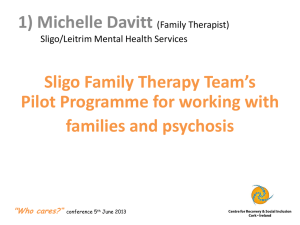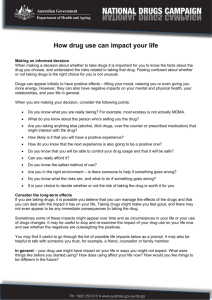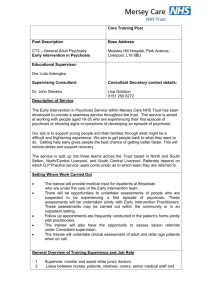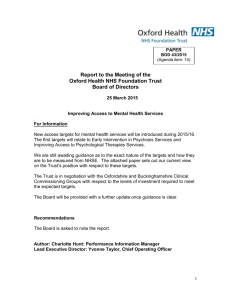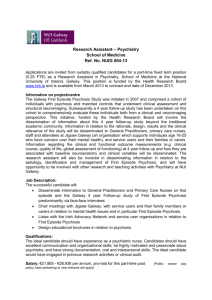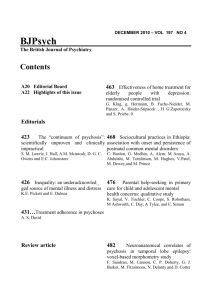Unify collection guidance
advertisement
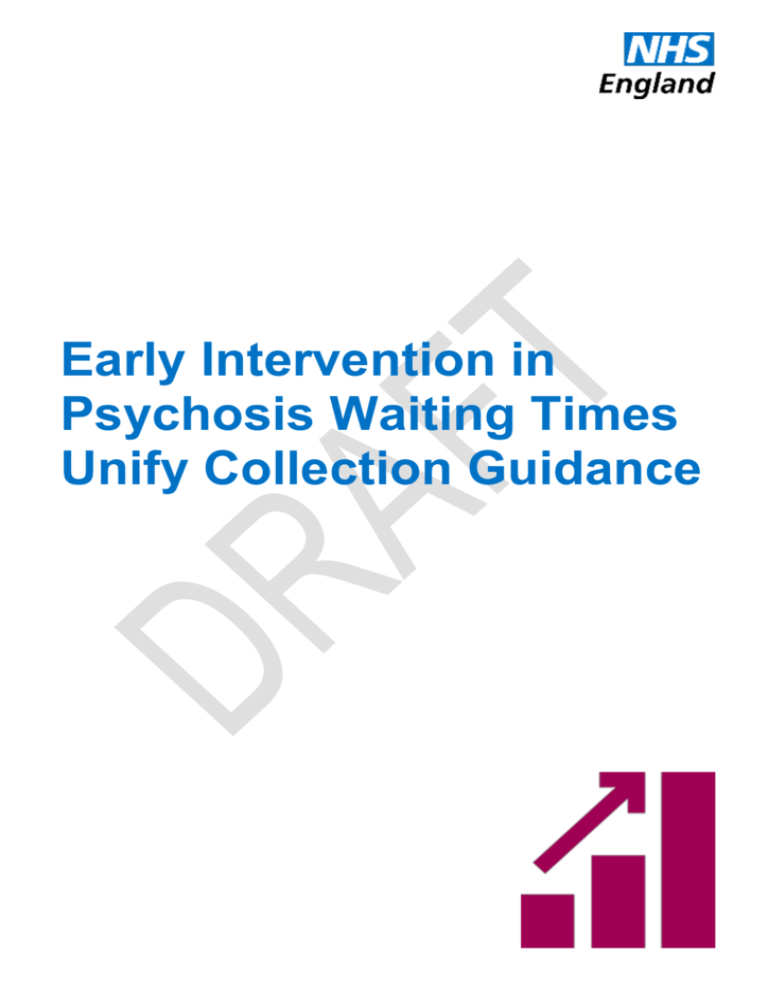
Early Intervention in Psychosis Waiting Times Unify Collection Guidance Choose an item. Document Title: Early Intervention in Psychosis Waiting Times Unify Collection Guidance Version number: 0.1 First published: Updated: Prepared by: Gareth Staton Classification: (OFFICIAL) The National Health Service Commissioning Board was established on 1 October 2012 as an executive non-departmental public body. Since 1 April 2013, the National Health Service Commissioning Board has used the name NHS England for operational purposes. 2 Choose an item. Contents Contents ..................................................................................................................... 3 1 Background ......................................................................................................... 4 1.1 Who is this guide for? .................................................................................... 4 1.2 What is the Access and Waiting Time Standard for Early Intervention in Psychosis Services? ............................................................................................... 4 2 Measuring waiting times ...................................................................................... 4 2.1 Clock starts: referral, recognition and assessment ........................................ 4 2.2 Clock stop: start of treatment ......................................................................... 5 3 Completing the return .......................................................................................... 6 4 Frequently asked questions................................................................................. 7 5 Contact and support ............................................................................................ 8 3 Choose an item. 1 Background 1.1 Who is this guide for? This guide is aimed at the people in provider organisation who will complete and submit the Unify return for Early Intervention in Psychosis waiting time. It should be read in conjunction with The Forward View into action: Supplementary information for commissioner planning 2015/16 – Technical definitions for commissioners1, Guidance to support the introduction of access and waiting time standards for mental health services in 2015/162 and the Implementing the Access and Waiting Time Standard for Early Intervention in Psychosis Services Commissioning Guide3 1.2 What is the Access and Waiting Time Standard for Early Intervention in Psychosis Services? The access and waiting time standard requires that, from 1 April 2016, more than 50% of people experiencing first episode psychosis will be treated with a NICEconcordant package of care within 2 weeks of referral. The standard is thus ‘two pronged’ and both conditions must be met for the standard to be judged to have been achieved. This standard will apply whenever it is suspected that someone is experiencing a first episode of psychosis. This therefore extends the traditional scope of early intervention for psychosis services (aged 14-35 years) to encompass all ages in line with the NICE guideline. 2 Measuring waiting times 2.1 Clock starts: referral, recognition and assessment 1 http://www.england.nhs.uk/wp-content/uploads/2015/02/6-tech-defi-comms-0215.pdf http://www.england.nhs.uk/wp-content/uploads/2015/02/mh-access-wait-time-guid.pdf 3 Insert link to Commissioning Guidance when published. 2 4 Choose an item. The clock for the two-week pathway starts when a referral is received by a mental health service; this will include referrals direct to an EIP service but also to Community Mental Health Teams, CAMHS, inpatient psychiatric unit or to a single point of access, or any other referral route into secondary care mental health services. The principle is that the clock starts on the day that the secondary care provider receives a referral. Some Trusts operate a single point of access or triage, while others accept direct referrals to an EIP service. If a single point of access or triage service receives a referral flagged as ‘suspected first episode psychosis’ this will start the clock. If a single point of access or triage service receives a referral not flagged as ‘suspected first episode psychosis’, but the person is assessed or triaged as such, this should be flagged and moved onto the first episode psychosis pathway, and the clock will start on the date that the single point of access or triage service received the referral. If a single point of access or triage service receives a referral flagged as ‘suspected first episode psychosis’, but it is triaged as clearly not psychosis, the referral will not enter the pathway or be counted against the Access and Waiting Time Standard. If an EIP service accepts referrals directly, this will start the clock. If an internal source assesses a person within the service as having a suspected first episode psychosis, referral should be made immediately to an EIP service and the clock started. The clock starts regardless of referral source, including from out of area, the age of the person being referred or comorbidities such as learning disabilities, drug misuse, personality disorder or autism. The only exemptions from these arrangements will be referrals of people who are experiencing psychotic symptoms with a medical or surgical cause. 2.2 Clock stop: start of treatment 5 Choose an item. Assessment should be completed by a competent and qualified professional (see commissioning guidance for detailks). The EIP assessment will ascertain whether the person is either: experiencing first episode psychosisis or not experiencing first episode psychosis but may have an at-risk mental stated does not have evidence of first episode psychosis or of an at-risk mental state. The clock will stop if either: The person is experiencing first episode psychosis, or they may potentially be experiencing first episode psychosis and they have been allocated to a care coordinator from an accredited EIP service. The person is not experiencing first episode psychosis but may have an at-risk mental stat and they have • been allocated to a care coordinator from an accredited EIP service, and • an at-risk mental state assessment has commenced by an appropriately trained and qualified clinician. If a patient does not have evidence of first episode psychosis or of an at-risk mental state they will exit the pathway and a waiting time will not be captured. 3 Completing the return The return requires details of : Completed pathways – all pathways where a patient entered treatment during the reporting period (month). Only include pathways for patients who are experiencing first episode psychosis or an at risk mental state. Incomplete pathways – all pathways where a patient is still waiting to enter treatment at the end of the reporting period (month). This may include both patients waiting for assessment and those who have been assessed but are waiting to be added to the caseload of a suitably qualified clinician. 6 Choose an item. 4 Frequently asked questions Which organisations need to complete this return? All organisations which provide Early Intervention in Psychosis service should complete the return. Can’t this information be collected via the Mental Health and Learning Disability Dataset (MHLDDS)? EIP waiting times cannot currently be calculated from the MHLDDS. The next version of the dataset (which will be renamed the Mental Health Services dataset) will include the data items required to calculate EIP waiting times. This version of the dataset is not expected to flow until January 2015. Is this a permanent collection? This is an interim collection and it is intended that it will be withdrawn once data from the Mental Health Services Dataset is sufficiently robust. There will be a period of parallel running whilst this is assessed. Do we only need to include patients from local CCGs? Please ensure that you include all patients who have been referred to EIP services in your return including those from outside your immediate area. Do we all referrals to EIP services need to be included? All referrals for suspected first episode psychosis should be included in the return. If patient is already on the caseload of another EIP service and receiving treatment but has been referred for another reason (e.g. the patient is relocating) they do not need to be included. Do DNAs stop the clock? Ambivalence to a mental health referral/assessment is common and natural on the part of service users (and sometimes families too) and the first assessment is a critical step in an engagement process on which therapeutic alliances and interventions build. Where people referred do not attend or agree to an initial assessment, contact can be made with the referrer and with family members or carers to gather further information and to provide support and advice to the family where they have already become involved. Where family/carers have not been involved, a decision to contact them can be made if a safety assessment of the available information warrants it. Attempts need to continue to be made to engage the person and make an assessment including visiting them at home or a mutually agreed location. Depending on the urgency of the situation, this should occur at least twice within the 14 day period after referral and more frequently if there are safety issues, if necessary in collaboration with acute care teams. If contact has not been possible, a care coordinator should be allocated within the 14-day period to continue the 7 Choose an item. attempts to complete an assessment and liaise with carers and referrer. In these circumstances, if there is enough suspicion of the presence of psychosis that the EIP service should continue to work with the family and carers, this may include the allocated care coordinator undertaking therapeutic work with the family. Delivery of family education and continued support or intervention by a trained and supervised practitioner (see section 5.1) would ‘stop the clock’ at this point. Efforts need to continue to be made to engage the person and make an assessment including visiting them at home or a mutually agreed location. How will the data be published? The data will be published via the NHS England Statistics website4 once there is sufficient coverage and quality of returns. 5 Contact and support For further queries relating to this collection please contact: Insert contact email address when confirmed. 4 http://www.england.nhs.uk/statistics 8
